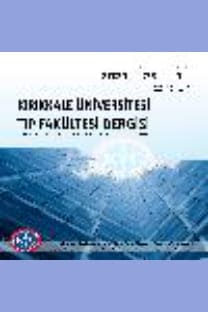Hastanede Çalışan Sağlık Personelinde COVID-19 Görülme Sıklığı ve Bulaş Yollarının Değerlendirilmesi
COVID-19, sağlık çalışanı, hastane, bulaşma
EVALUATION OF THE PREVALENCE AND TRANSMISSION ROUTES OF COVID-19 IN HEALTHCARE PERSONNEL WORKING IN THE HOSPITAL
COVID-19, Healthcare Worker, Hospital, Transmission,
___
- Sağlık Bakanlığı. Covid-19 (SARS-CoV-2 Enfeksiyonu) Genel Bilgiler, Epidemioloji ve Tanı. Bilim Kurulu Çalışması. Accessed date: 03 January 2021:https://covid19.saglik.gov.tr/.
- Chou R, Dana T, Buckley DI, Selph S, Fu R, Totten AM. Epidemiology of and risk factors for coronavirus ınfection in health care workers: A living rapid review. Ann Intern Med. 2020;173(2):120-36. doi: 10.7326/M20-1632.
- Sağlık Bakanlığı. Covid-19 (SARS-CoV-2 Enfeksiyonu) Temaslı Takibi, Salgın Yönetimi, Evde Hasta İzlemi ve Filyasyon. Bilim Kurulu Çalışması. Accessed date: 03 January 2021: https://covid19.saglik.gov.tr/.
- Singhal T. A review of coronavirus disease-2019 (COVID-19). Indian J Pediatr 2020;87(4):281-6.
- Gökçek MB, Aslaner H, Çetin A, Yıldız S, Benli AR. Medical surveillance: Filiation. Jour Turk Fam Phy 2021;12(1):40-9.
- Gómez-Ochoa SA, Franco OH, Rojas LZ, Raguindin PF, Roa-Díaz, ZM, Wyssmann BM et al. COVID-19 in health-care workers: A living systematic review and meta-analysis of prevalence, risk factors, clinical characteristics, and outcomes. American journal of epidemiology. 2021;190(1):161-175.
- Çalışkan-Pala S, Metintas S. COVID-19 pandemisinde sağlık çalışanları. ESTÜDAM Halk Sağlığı Dergisi. 2020;5:156-68.
- Sahu AK, Amrithanand VT, Mathew R, Aggarwal P, Nayer J, Bhoi S. COVID-19 in health care workers - A systematic review and meta-analysis. Am J Emerg Med. 2020;38(9):1727-31.
- Dzinamarira T, Murewanhema G, Mhango M, Iradukunda PG, Chitungo I, Mashora M et al. COVID-19 prevalence among healthcare workers. A systematic review and meta-analysis. Int J Environ Res Public Health. 2021;19(1):146.
- The Novel Coronavirus Pneumonia Emergency Response Epidemiology Team. The epidemiological characteristics of an outbreak of 2019 novel coronavirus diseases (COVID-19) - China, 2020[J]. China CDC Weekly. 2020;2(8):113-22.
- Sağlık Bakanlığı. Bakan Koca, koronavirüse ilişkin son durumu değerlendirdi. Accessed date: 01 March 2021: https://www.saglik.gov.tr/TR,68676/bakan-koca-koronaviruse-iliskin-son-durumu-degerlendirdi.html.
- Alsohime F, Temsah MH, Al-Nemri AM, Somily AM, Al-Subaie S. COVID-19 infection prevalence in pediatric population: Etiology, clinical presentation, and outcome. J Infect Public Health. 2020;13(12):1791-96.
- Bandyopadhyay S, Baticulon RE, Kadhum M, Alser M, Ojuka DK, Badereddin Y et al. Infection and mortality of healthcare workers worldwide from COVID-19: A systematic review. BMJ Glob Health. 2020;5(12):e003097.
- Zheng C, Hafezi-Bakhtiari N, Cooper V, Davidson H, Habibi M, Riley P et al. Characteristics and transmission dynamics of COVID-19 in healthcare workers at a London teaching hospital. J Hosp Infect. 2020;106(2):325-9.
- Sağlık Bakanlığı. COVID-19 Bilgilendirme Platformu. Accessed date: 01 March 2021: https://covid19.saglik.gov.tr/TR-66935/genel-koronavirus-tablosu.html.
- COVID-19 pandemisi’nde meslek hastalığı tanı kılavuzu. Accessed date: 02 December 2021: https://korona.hasuder.org.tr/wp-content/uploads/Mesleksel-COVID_19_Tan%C4%B1_Rehberi_2020.pdf.
- Burke RM, Midgley CM, Dratch A, Fenstersheib M, Haupt T, Holshue M et al. Active monitoring of persons exposed to patients with confirmed COVID-19 - United States, January-February 2020. MMWR Morb Mortal Wkly Rep. 2020;69(9):245-6.
- Işsever H, Işsever T, Oztan G. Epidemiology of COVID-19. Sağlık Bilimlerinde İleri Araştırmalar Dergisi. 2020;3(Suppl.1):1-13.
- Bayhan GI, Bedir-Demirbag T. Personnel protective equipment for healthcare professionals during COVID-19 pandemic. Turkish J Pediatr Dis. 2020;14(suppl):15-7.
- World Health Organization. What to do to keep yourself and others safe from COVID-19. Accessed date: 09 March 2021: https://www.who.int/emergencies/diseases/novel-coronavirus-2019/advice-for-public.
- Departman of Health (Austrailan Govenment). Protect yourself and others from COVID-19. Accessed date: 19 May 2022: https://www.health.gov.au/health-alerts/covid-19/protect-yourself-and-others.
- ISSN: 2148-9645
- Yayın Aralığı: Yılda 3 Sayı
- Başlangıç: 1999
- Yayıncı: KIRIKKALE ÜNİVERSİTESİ KÜTÜPHANE VE DOKÜMANTASYON BAŞKANLIĞI
Hayriye Mihrimah OZTURK, İrem EKMEKÇİ ERTEK
RESPİRATUVAR DİSTRES SENDROMLU PREMATÜRE BEBEKLERDE SURFAKTAN UYGULANMASINDA GÜNCEL METOTLAR
AKCİĞER KANSERLİ HASTALARIN ÖLÜM YERLERİ VE PALYATİF BAKIM
Makbule Özlem AKBAY, Özlem ORUÇ, Eylem TUNÇAY, Merve HÖRMET, Kübra AKYÜZ, Ethem YILDIZ, Taner SEZGİN, Muhsine Ahsen HOCAOĞLU, Vahide DEMİRCİ, Buse Nur ERTAM, Zuhal KARAKURT
Gebelikte Frontal QRS-T Açısının Değerlendirilmesi
Emre YILMAZ, Kıymet İclal AYAYDIN YILMAZ, Ercan AYDIN
ÇOCUKLARDA BÜYÜME HORMONU TEDAVİSİ: TEK MERKEZ DENEYİMİ
Hastanede Çalışan Sağlık Personelinde COVID-19 Görülme Sıklığı ve Bulaş Yollarının Değerlendirilmesi
İzzettin TOKTAŞ, İbrahim VAKİT, Süleyman VARSAK, Özgür ERDEM, Gülşen YALÇIN, Celal ÖZCAN
YOZGAT YÖRESİNDE ALT GASTROİNTESTİNAL SİSTEM ENDOSKOPİ SONUÇLARININ ANALİZİ
Oktay Faysal TERTEMİZ, Nermin TEPE
PULMONER EMBOLİ HASTALARINDA ORTALAMA TROMBOSİT HACMİNİN DEĞERLENDİRİLMESİ
